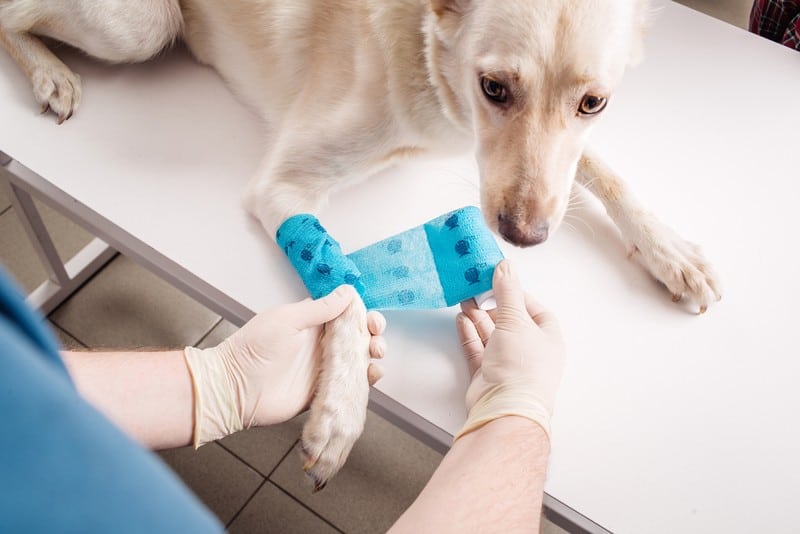Osteoarthritis is a common ailment of dogs – particularly those who are getting a little long in the tooth.
Fortunately, there are a variety of medications and treatments available to help ease your pup’s pain. Metacam is one such example, and many vets prescribe it to their patients with achy joints.
We’ll explain everything you need to know about the drug below.
What is Metacam For Dogs?
Metacam is the name brand for the drug meloxicam. It is used to treat the pain and inflammation associated with osteoarthritis in dogs. It’s also available for people.
However, meloxicam for humans is typically sold under the brand name Mobic. Just understand that both medications are formulated differently, so (as always), you should refrain from giving your dog your prescription or vice-versa.
How Does Metacam Work?
Metacam is an NSAID – the same class of drugs containing aspirin and ibuprofen. However, metacam is safe for dogs, whereas aspirin and ibuprofen can be toxic to four-footers.
Like other NSAIDs, Metacam is non-steroidal, and it primarily works by reducing the hormones in your pet’s body that trigger inflammation and the sensation of pain.
Metacam for Dogs Side Effects
Like most other medications, Metacam can cause some side effects in dogs.
Most are relatively minor, but a few may require your vet to stop prescribing the medication and search for an alternative that your dog can tolerate better.
Some of the most notable side effects of the drug include:
- Minor gastrointestinal disturbance, such as vomiting or diarrhea
- Decreased appetite
- Increased water consumption and urination
- Black, tarry, or bloody stools
- Incoordination
- Seizures
- Aggression
- Yellowing of the eyes and gums (jaundice)
- Stomach ulcers
- Weight loss
- Skin irritation

Metacam For Dogs Dosage Guide
You must always administer Metacam in the exact manner and amount your vet recommends. This is the only way to know how much Metacam to give your dog.
Some dogs require different dosages than are commonly recommended, so don’t just look up a Metacam dosage calculator for dogs – stick with the dosage your vet prescribes.
Most vets typically administer a loading dose during the office visit at a rate of 0.09 milligrams per pound on the first day, and 0.045 milligrams per pound afterward.
However, it is important to note that meloxicam suspensions are available in multiple formulations – some contain 0.5 milligrams of the medication per milliliter of fluid, while others contain 1.5 milligrams of medication per milliliter of fluid.
Accordingly, you’ll want to double check with your veterinarian to ensure you administer the correct meloxicam liquid dosage.
How Is Metacam Administered to Dogs?
Metacam comes in liquid suspension form, and a dispensing syringe or dropper is usually included.
The medication appears to be palatable for most dogs, so it’s rarely very difficult to administer. It is also available as an injectable medication, but this is not prescribed by vets as often as the oral form.
Some veterinarians recommend simply placing the required amount directly in your dog’s mouth (on the back of the tongue), while others prefer their clients to add the medicine to food, which can then be given to your dog.
In either case, just be sure to give the medication to your pet with food or shortly (less than 10 minutes) after eating. This can help reduce the chances of your pet suffering a stomach ulcer.
If, for some reason, you forget to administer the medication to your pet at the regular time, just go ahead and give your pet the missed dose as soon as you remember. Just make this time your “new normal.”
In other words, if you’ve been giving your dog his medication at 10:00 AM, and you forget to do so until 12:00PM, make noon his new dosing time.

If, for some reason, you forget to administer the medication to your pet at the regular time, just go ahead and give your pet the missed dose as soon as you remember.
However, if it is nearly time for your dog’s next dose, simply skip the forgotten dose and administer it again at the normal time. Do not give a double dose of the medicine to make up for the lost one.
Be sure to store meloxicam at room temperature, between 68° – 77° Fahrenheit, and avoid giving it to your pet after the expiration date.
Metacam Without Vet Prescription: Can I Get It Myself?
Because it isn’t appropriate for all dogs, it may interact with other medications, and it can (rarely) cause serious side effect, meloxicam is only available with a prescription from your vet.
You may find online retailers who are willing to sell you Metacam without a prescription, but buying your pet’s medications in this manner is a very bad idea.
Aside from the issues with side effects and interactions discussed above, you have to wonder how ethical a retailer is if they’ll illegally sell prescription drugs.
The medications you purchase may not be what they’re labeled as, and they may even be contaminated with dangerous additives.
Mobic (the human form of the drug) also requires a prescription to purchase. Don’t be tempted to give Mobic to your dog if you have a prescription, as the human formulation may contain inactive ingredients that are not safe for your pet.
Where to Buy Meloxicam for Dogs
There are a variety of places to legally purchase Metacam with a prescription. Your vet may stock the medication, which is the easiest place to purchase it from (you’ll already be there anyway).
However, you can also obtain it from a variety of online retailers.
We recommend buying meloxicam from Chewy.com. They stock Metacam (the name brand form of the medicine), and they also have the generic Metacam formulation available, if you’d like to save some cash.
Simply follow the steps listed on their website to submit your proof of prescription and get your pup’s meds on their way.

Metacam for Dogs Reviews
According to owners who’ve tried the medication on their pups, the reviews for Metacam are a bit mixed.
The medication does appear to help alleviate or reduce joint pain for most dogs, but it it is important to be realistic about your expectations. In other words, while Metacam is very effective at reducing pain, it won’t cause your 12-year-old Lab with advanced arthritis to start doing pirouettes across the living room.
Some dogs don’t seem to suffer from any troubling side effects, while others suffer relatively serious side effects, that require them to stop taking the medicine entirely.
The only way you’ll know if Metacam will be helpful for your pet is to discuss it with your vet, obtain a prescription, and then give it a try.
Your vet can help you figure out whether or not it makes sense to keep using the medicine after trying it out for a few weeks or months.
Metacam Alternatives: Other Treatments for Osteoarthritis
Metacam is a pretty effective treatment for arthritis pain, but it isn’t the only pain treatment for dogs available.
In fact, there are a variety of other things you may want to talk to your vet about if Metacam isn’t right for your pup.
We’ll discuss a few of the best options below, but make sure you check out our definitive guide to arthritis treatments as well!
Other NSAIDs: Metacam vs. Rimadyl, Deramaxx and Other Medications
Metacam is one of the most commonly prescribed NSAIDs for dogs, but it isn’t the only game in town.
Several other NSAIDs – such as Rimadyl, Deramaxx, or Etogesic — may help treat your dog’s arthritis pain, if Metacam isn’t right for her for some reason.
Some vets may also prescribe ketoprofen for dogs with arthritis, but because of the side effects it often causes, it isn’t recommended as often as other NSAIDs, which are generally better tolerated.
Ibuprofen and aspirin are also NSAIDs, but they can cause a variety of side effects and they aren’t often recommended for dogs.
Just remember that you should never give your dog these or any other medications without first consulting your vet.
Steroids
Steroids, especially prednisone, are occasionally used to treat arthritis in dogs. These medicines are often very effective at reducing the inflammation and swelling associated with arthritis, but they also cause a number of side effects – particularly during long-term use.
Accordingly, steroids are not prescribed as often as they were decades ago to treat canine arthritis pain.
Other Pain Killers
Dogs who have severe arthritis may require alternative medications to achieve good results. This includes synthetic opioids like tramadol, as well as drugs that target the way nerves transmit information, such as gabapentin.
These medications are rarely prescribed until other medications have proven unsatisfactory.
Surgery
In rare cases, surgery may allow your vet to improve your dog’s mobility and reduce some of the joint pain she feels.
Surgery is obviously not something you should take lightly, as all surgical procedures present risks. However, severe arthritis can drastically reduce your dog’s quality of life, and surgery may be the only viable option left.
Laser Therapy
Laser therapy is a relatively new avenue that some vets are using to treat arthritis and other problems in dogs. It is thought to help stimulate cell regeneration and increase blood flow to the target region.
Laser therapy has a lot going for it: It’s painless, most dogs don’t mind the procedure (some appear to enjoy it), and it isn’t prohibitively expensive.
However, not all vets provide such treatments, so you may have to hunt around a bit to find one who’ll perform the procedure on your pet.

Home Treatments for Dog Arthritis
Let’s be clear: Moderate to severe arthritis will usually require your vet’s help to address. But that doesn’t mean there aren’t a few things you can do on your own, which may further improve your dog’s quality of life.
Most of these treatments and strategies are safe, but it’s still a good idea to mention them to your vet so that he or she has a complete understanding of the way you’re caring for your pet.
Nutritional Supplements
Medications aren’t the only way to help alleviate your dog’s pain. Some owners have been able to help their pooch feel better by providing joint-supporting supplements or by switching to a food that is already fortified.
- Chondroitin and glucosamine are the two most widely used supplements for improving joint health, and there is some evidence to back their efficacy.
- Omega-3 fatty acids (often administered through fish oil supplements) may also help in some cases, as they tend to reduce inflammation. Similarly, green-lipped mussels or MSM may also prove helpful.
Warm Clothing
Warm clothing isn’t exactly a silver bullet for treating osteoarthritis, but some dogs will enjoy improved mobility and some pain relief by wearing a cozy canine winter coat.
This is most helpful for dogs living in cold climates (you don’t want to put clothing on a dog when the temperatures are high).

Orthopedic Mattresses
Orthopedic mattresses and memory foam mattresses can be very helpful for easing arthritis pain, improving mobility, and helping your pup get a good night’s sleep.
And best of all, you can use these types of super-supportive beds alongside just about any other treatment strategy – including pain medications like Metacam.
Be sure to check out our review of the best memory foam dog beds on the market, to see some of the best options for your pet.
Heated Pet Beds
Heated pet beds are an alternative to orthopedic mattresses (although some beds may feature memory foam mattresses and heating elements).
By providing gentle warmth for your dog’s joints, a heated bed may help alleviate some pain and improve mobility your dog is experiencing.
If you think a heated pet bed may be a good idea for your pet, see our top suggestions for heated dog beds here!
Weight Loss
Weight loss won’t directly reduce your dog’s joint pain or inflammation, but it will take some of the stress off her joints.
You obviously can’t do this if your pup is already at or below an ideal body weight, but the sad fact is, an alarming number of pets are overweight.

Chances are, if your dog is overweight, your vet will go ahead and mention weight loss during your initial office visit.
But, if he or she doesn’t, make sure you ask about it. It’s not only important to make sure your dog is healthy enough to shed a few pounds, but you’ll want to discuss the proper way of helping her lose weight with your vet.
From switching to a weight loss dog food, to ramping up the exercise, to decreasing the amount of food you food your pooch, there are several strategies you can use to help your dog get health.
Install Dog Ramps
Ramps aren’t going to directly reduce your dog’s pain, but they are valuable tools in the quest to help your pup.

For starters, they’ll make it easier for your poor pooch to get up on to her favorite couch or allow her to sidestep the stairs that may give her trouble.
A ramp will also help eliminate some of the joint damage that can occur over time, as your dog is forced to jump on or off of things.
We’ve written extensively about doggie ramps before, so be sure to check out our recommendations for dog ramps (and DIY dog ramp options) we recommend.
Massage or Acupuncture
Massage and acupuncture are two alternative treatments that may provide some relief for dogs suffering from arthritis.
There isn’t a lot of evidence to demonstrate the efficacy of either technique for treating your dog, but both appear to be safe (when performed by properly trained practitioners), and your dog may enjoy the attention and human contact.
So, they may be worth exploring further – just be sure to discuss them with your vet before starting either type of therapy.
***
Osteoarthritis is an unfortunately common ailment that afflicts many dogs as they age. And while there is no cure for the condition, it is treatable with several medications, including Metacam.
This means you should consider asking your vet about the medicine, if your dog is suffering from achy joints.
Have you ever tried Metacam for your dog’s arthritis? We’d love to hear about your experiences. Let us know if it helped ease your pet’s pain and tell us about any side effects it caused too.














Leave a Comment